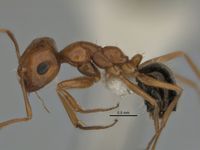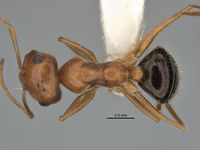Melophorus caeruleoviolaceus
| Melophorus caeruleoviolaceus | |
|---|---|

| |
| Scientific classification | |
| Kingdom: | Animalia |
| Phylum: | Arthropoda |
| Class: | Insecta |
| Order: | Hymenoptera |
| Family: | Formicidae |
| Subfamily: | Formicinae |
| Tribe: | Melophorini |
| Genus: | Melophorus |
| Species group: | biroi |
| Species complex: | wheeleri |
| Species: | M. caeruleoviolaceus |
| Binomial name | |
| Melophorus caeruleoviolaceus Heterick, Castalanelli & Shattuck, 2017 | |
The species has been found in remote desert and semi-arid areas in (at the least) NSW, NT, SA and WA, ecological data are wanting. (Heterick et al. 2017)
Identification
Heterick et al. (2017) - Melophorus caeruleoviolaceus can be placed in the Melophoprus biroi species-group on the basis of characters of the clypeus, propodeum, mandible and palps. The species is also placed in the Melophoprus wheeleri species-complex because it agrees with the following apomorphies possessed by the complex: the minor worker often has more than five teeth, the largest major worker has a short, massive, elbowed mandible directed posteriad; in profile, the maxillary palps are short in the major and generally short in minor workers (in the minor worker, usually only attaining the neck sclerite at their maximum extent when the head is moderately inclined) and, in full-face view, the anterior margin of the clypeus in the large major worker is usually planar or weakly concave (variable in other subcastes but planar or narrowly protuberant anterior clypeal margins predominate). Within its complex, M. caeruleoviolaceus is characterised as a strongly bicoloured, relatively smooth species with black, brown or variegated brown head, orange mesosoma and black gaster, the gaster and often the head (in darker morphs) with distinct bluish to violet iridescence. This colour pattern is found in all subcastes but the colour pattern and bluish or violet iridescence is not shared by any other member of the M. wheeleri species-complex.
Although the overall appearance of this species is typical of many of the Melophoprus biroi complex, the violet iridescence on the gaster, and, in some instances, bluish iridescence on the head and body of the ant, make even old museum specimens strikingly attractive and serve to distinguish this ant from other Melophorus. The taxon is morphologically similar to Melophorus setosus, and the minor worker shares the same protuberant clypeus, square vertex and porrect, rounded node. Melophorus setosus, however, is visibly covered in short, markedly modified erect setae, while the setae in M. caeruleoviolaceus are only slightly spatulate at their ends. Moreover, the major worker of M. setosus has the characteristic mandible of the Melophoprus fieldi complex, unlike the crushing wheeleri-type mandible found in major workers of M. caeruleoviolaceus.
Distribution
Distribution based on Regional Taxon Lists
Australasian Region: Australia (type locality).
Distribution based on AntMaps
Distribution based on AntWeb specimens
Check data from AntWeb
Countries Occupied
| Number of countries occupied by this species based on AntWiki Regional Taxon Lists. In general, fewer countries occupied indicates a narrower range, while more countries indicates a more widespread species. |

|
Estimated Abundance
| Relative abundance based on number of AntMaps records per species (this species within the purple bar). Fewer records (to the left) indicates a less abundant/encountered species while more records (to the right) indicates more abundant/encountered species. |

|
Biology
Castes
Worker
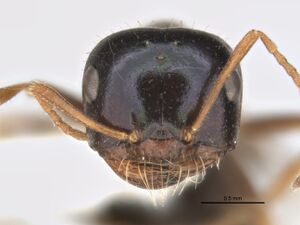 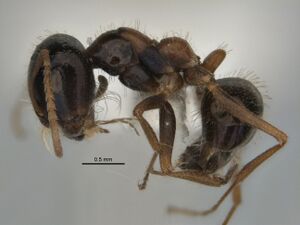 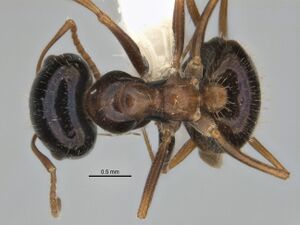 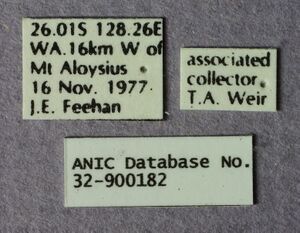
| |
| . | |
Phylogeny
| Melophorus |
| ||||||||||||||||||||||||||||||||||||
Based on Heterick et al., 2017. Only selected species groups/complexes are included.
Nomenclature
The following information is derived from Barry Bolton's Online Catalogue of the Ants of the World.
- caeruleoviolaceus. Melophorus caeruleoviolaceus Heterick, Castalanelli & Shattuck, 2017: 331, fig. 77 (w.) AUSTRALIA.
Unless otherwise noted the text for the remainder of this section is reported from the publication that includes the original description.
Sequencing has been carried out on one worker collected in hummock grassland near Pannawonica, WA. On a five-gene tree the WA specimen is placed near to Melophorus parvimolaris, but is sister to Melophorus chauliodon on a three-gene tree, and this is likely to be the more accurate placement.
Description
Worker
(n = 6): CI 108–125; EI 21–31; EL 0.22–0.30; HL 0.68–1.15; HW 0.73–1.44; ML 0.97–1.54; MTL 0.59–0.86; PpH 0.11–0.18; PpL 0.40–0.63; SI 66–97; SL 0.71–0.95.
Minor. Head. Head square; posterior margin of head weakly convex; frons shining with superficial shagreenation or microreticulation only; pilosity of frons a mixture of a few well-spaced, erect setae interspersed with appressed setae only. Eye moderate (eye length 0.20–0.49 length of side of head capsule); in full-face view, eyes set above midpoint of head capsule; in profile, eye set anteriad of midline of head capsule; eyes elliptical or slightly reniform. In full-face view, frontal carinae straight, divergent posteriad; frontal lobes straight in front of antennal insertion. Anteromedial clypeal margin broadly and evenly convex; clypeal psammophore set at or above midpoint of clypeus; palp formula 6,4. Five to six mandibular teeth in minor worker; mandibles triangular, weakly incurved; third mandibular tooth distinctly shorter than apical tooth and teeth numbers two and four; masticatory margin of mandibles approximately vertical or weakly oblique. Mesosoma. Integument of pronotum, mesonotum and mesopleuron moderately shining and shagreenate throughout; anterior mesosoma in profile broadly convex; appearance of erect pronotal setae short, (i.e., longest erect setae shorter than length of eye) and unmodified; in profile, metanotal groove shallow, broadly V- or U-shaped; propodeum shining and finely striolate and microreticulate; propodeum smoothly rounded or with indistinct angle, or angulate, propodeal angle blunt; length ratio of propodeal dorsum to its declivity about 4:3; erect propodeal setae present and abundant (greater than 12); appressed propodeal setulae short, separated by more than own length and inconspicuous; propodeal spiracle situated on or beside declivitous face of propodeum, and shorter (length < 0.50 × height of propodeum). Petiole. In profile, petiolar node, squamiform or subcuboidal, vertex bluntly rounded; in full-face view, shape of petiolar node uniformly rounded; node shining and smooth with vestigial sculpture. Gaster. Gaster shining, shagreenate (‘LP record’ appearance); pilosity of first gastral tergite consisting of a mixture of curved, erect and semi-erect setae and decumbent and appressed setae that form a variable pubescence. General characters. Colour of most of head, and coxae blackish-brown, mesosoma orange tan, gaster black; gaster (and often, head) with violet iridescence.
Major. Head. Head horizontally rectangular, broader than wide; posterior margin of head planar or weakly concave; cuticle of frons matt or with weak sheen, indistinctly shagreenate; pilosity of frons a mixture of many short, erect, bristly setae interspersed with regularly spaced appressed setae. Eye moderate (eye length 0.20–0.49 length of head capsule); in full-face view, eyes set above midpoint of head capsule; in profile, eye set anteriad of midline of head capsule; roughly ovoid, eye narrowed posteriad. In full-face view, frontal carinae straight, divergent posteriad; frontal lobes curved inward in front of antennal insertion. Anterior clypeal margin straight; clypeal psammophore set at or above midpoint of clypeus; palp formula 6,4. Four distinct mandibular teeth in major worker; mandibles weakly incurved; third mandibular tooth distinctly shorter than apical tooth and teeth numbers two and four; masticatory margin of mandibles approximately aligned vertically or weakly oblique. Mesosoma. Integument of pronotum, mesonotum and mesopleuron moderately shining and shagreenate throughout; anterior mesosoma in profile broadly convex; erect pronotal setae short, (i.e., shorter than length of eye) and unmodified; in profile, metanotal groove shallow, broadly V- or U-shaped; propodeum shining, with multiple hair like striolae; propodeum angulate, propodeal angle blunt; length ratio of propodeal dorsum to its declivity between 1:1 and 1:2; erect propodeal setae present and abundant (at least a dozen); appressed propodeal setae short, separated by more than own length and inconspicuous; propodeal spiracle situated at least twice its width from the declivitous face of propodeum, and shorter (length less than 0.50 × height of propodeum). Petiole. In profile, petiolar node narrowly conical, vertex blunt; in full-face view, shape of petiolar node uniformly rounded; node shining and faintly shagreenate-microreticulate. Gaster. Gaster weakly shining with indistinct shagreenation; pilosity of first gastral tergite consisting of well-spaced, short, thick, erect setae interspersed with minute, appressed setae. General characters. Colour of head, mesosoma and coxae variegated blackish-brown and orange tan, gaster black; gaster (and, often, head) with violet iridescence.
Type Material
Holotype minor worker (middle ant) from 53 km E of Vokes Hill, Victoria Desert, South Australia, 9 October 1976, P.J.M. Greenslade, (11) [ANIC32-900183] (Australian National Insect Collection). Paratypes: media worker and minor worker on same pin and with same details as holotype (ANIC); 4 minor workers from Emily Gap, Northern territory, 18 May 1978, Zhakharov, nest N65 [ANIC32-0133892] (The Natural History Museum); 2 major workers from 16 km W of Mt Aloysius 26.015S, 128.26'E, Western Australia, 16 November 1977, J. E. Feehan, associated collector T. A. Weir [ANIC32-900182] (Museum of Comparative Zoology); 3 minor workers from Wilgena Hill E. Tarcoola, South Australia, 2 October 1976, P.J.M. Greenslade, (3)a. (South Australian Museum); minor worker from 146.8 km SSE of Newman 24°35'21"S, 120°15'40"E, Western Australia, April 1997, S. van Leeuwen & R. N. Bromilow, Perm. Invert. pitfall trap B1. Mulga woodland [JDM32-004943] (Western Australian Museum).
Etymology
Latin caeruleus (‘sky-blue’) plus violaceus (‘violet’); referring to the attractively bicoloured appearance of this species; adjective in the nominative singular.
References
- Heterick, B.E. 2021. A guide to the ants of Western Australia. Part I: Systematics. Records of the Western Australian Museum, Supplement 86, 1-245 (doi:10.18195/issn.0313-122x.86.2021.001-245).
- Heterick, B.E. 2022. A guide to the ants of Western Australia. Part II: Distribution and biology. Records of the Western Australian Museum, supplement 86: 247-510 (doi:10.18195/issn.0313-122x.86.2022.247-510).
- Heterick, B.E., Castalanelli, M., Shattuck, S.O. 2017. Revision of the ant genus Melophorus (Hymenoptera, Formicidae). ZooKeys 700, 1–420 (doi: 10.3897/zookeys.700.11784).
